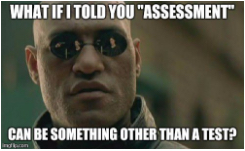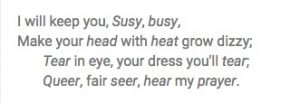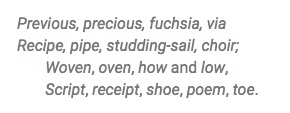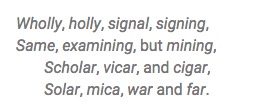MSM 338: Good Science Reeds . . . er, Reads and other fun things to do with English!
Jokes You Can Use:
What did the teacher say after breaking up a fight by two invisible students.
“Move along, folks. There’s nothing to see here!”
Advisory:

Middle School Science Minute
by Dave Bydlowski (k12science or davidbydlowski@mac.com)
3D Design Class
I was recently reading the Summer, 2016 issue of “Science Scope,” a magazine written for middle school science teachers, published by the National Science Teachers Association.
In this issue, I read the the article, “The New Standard in Technology Education: 3D Design Class.” It was written by Andrew Gillen. The article explains how to get started in 3D design and provides an introductory 3D modeling course outline.
From the Twitterverse:
@DruTomlin_AMLE Link to #trustmapping journal article by Peter Cavanagh http://www.adolescentsuccess.org.au/wp-content/uploads/2013/10/AdolescentSuccess_November_Volume14-2.pdf …
Will Richardson @willrich45 New Jersey, USA
Always interesting to me how we seem to ignore the very nature of learning when we talk about “learning.” It’s joy, not work.
7 retweets 13 likes
Free Teacher Tools for #BacktoSchool – Interest Inventories ready for your class! http://bit.ly/CFBTS2016N @ClassFlow
How do you add skills for only 1 student? Considering Using @ClassDojo to Support PBIS, IEPs & Special Education: http://ht.ly/wqQc30455Lg
9 creative ideas to help your students go device-free. #teaching #unplug http://bit.ly/2ca4OQ7
.@WMSWildcatNews 6th grdrs learn 2 open lockers – handy QR code linked 2 video lesson if needed #BYOD #1stday #acps
Is a student not a good test-taker?
iPad Apps for International Dot Day from @erintegration http://tonyv.me/erindot
Have you thought about why you are using #edtech before you jump in? #sketchnote via @sylviaduckworth #edchat
Dan McCabe @danieldmccabe Aug 22
Why I Tweet (As a Teacher) #edchat
#mschat every Thursday at 8:00 pm Eastern Standard Time. And as Troy says, “The Twitter never stops!”
Strategies:
World’s Largest Lesson
http://worldslargestlesson.globalgoals.org/
<iframe src=”https://player.vimeo.com/video/178464378″ width=”640″ height=”360″ frameborder=”0″ webkitallowfullscreen mozallowfullscreen allowfullscreen></iframe>
<p><a href=”https://vimeo.com/178464378″>The World's Largest Lesson 2016 – with thanks to Sir Ken Robinson and Emma Watson</a> from <a href=”https://vimeo.com/worldslargestlesson”>World's Largest Lesson</a> on <a href=”https://vimeo.com”>Vimeo</a>.</p>
Resources:
Fun with English
https://www.youtube.com/watch?v=tfRSvTSY0d4
Chemistry Books to Curl Up with
I have a set of books that Shawn might enjoy reading about Chemistry. I know he said that no one ever curls up with a good Chemistry book, but then again, maybe they do. Here are a few suggestions:
- Oliver Sacks – “Uncle Tungsten”: Oliver Sacks recently wrote a wonderful and poignant editorial in the NYT about his imminent fate, but the good doctor should rest supremely assured. All his writings are memorable and will live on forever, and none so much in my opinion as his delightful romp through the wonders of chemistry as a child narrated in “Uncle Tungsten”. I myself grew up experimenting with hazardous chemicals, and so this book resonated with me like few others. The book is a paean not just to the magical world of chemistry as explored by a young and receptive mind but also to a nostalgic and charming time when one could buy a pound of each alkali metal from a hardware store and drop it in a lake to see what happens (as Sacks did).
- Deborah Blum – “The Poisoner’s Handbook”: This volume is a riveting account of the sinister side of chemistry, and of human nature in general, as it manifested itself in the heyday of New York City during the Jazz Age. Blum is exceedingly accomplished at bringing out the devious motives of poisoners as they exploited the unique chemistry of each poisoning, and she is also very adept at chronicling the rise of forensic science as it pitted science against murder. Thankfully science has largely won that fight – Blum tells us how. If there’s any doubt about how chemistry can come alive and impact society in the most consequential and personal ways, this book should dispel that doubt.
- Natalie Angier – “Natural Obsessions”: Angier’s book is a rare example of an underexploited and revealing science genre; what one might call “fly on the wall science”. In this case the particular wall belongs to the laboratory of Robert Weinberg at MIT. Weinberg is one of the most important cancer researchers of the past fifty years and his lab has discovered many of the most important genes and biochemical pathways involved in the spread of this diabolical disease. Angier does a really great job of documenting the everyday struggles, passions, pitfalls, blind alleys and triumphs of basic research. Science done by human beings, with all its warts and glories.
- Barry Werth – “The Billion Dollar Molecule”: Another true fly on the wall account, Barry Werth’s book would get anyone interested in the fast-paced, high-stakes world of drug discovery and biotech research. It is quite definitely the best and only book I know in which a probing, highly articulate writer was allowed virtually untrammeled access to the secret world of cutting-edge research carried out by a major, upcoming company (Vertex Pharmaceuticals). Werth’s prose is breathless, vivid and Promethean and makes the scientists at Vertex alternatively look like Gods descended from Olympus and rock stars at Woodstock. While he takes some poetic license, nowhere else have I seen the real world of highly risky and lucrative drug research and the sheer passion of industrial scientists described with such loving care and attention to detail. A must read, along with its less stratospheric but still readable sequel.
- Philip Ball – “H2O: A Biography of Water”: If I had to single out one writer who consistently produces highly readable books on popular chemistry it would be Phil Ball. Phil has written many excellent books on the world of molecules and his writing covers a remarkable range of topics – from Paracelsus to Chartres Cathedral – but in my opinion none bridges the mundane and the profound as well as his book on that most beguiling, commonplace and enigmatic of substances – water. Phil explores an astounding range of phenomena in which water plays a key role, from the water cycle in glaciers to water in outer space to water at the molecular level in the human body. There is also a great chapter on what Irving Langmuir called “pathological science” which describes in gory detail the polywater controversy. This book is a must have on the shelf of anyone interested in popular chemistry.
http://wavefunction.fieldofscience.com/2015/04/top-10-popular-chemistry-books-for.html
Keep up the great work,
Dave
Web Spotlight:
Edmodo – Connect with your Facebook or Google accounts.
Gradecam – New interface rollout.
20 practical ways to use Google Forms in class, school
http://ditchthattextbook.com/2016/09/08/20-practical-ways-to-use-google-forms-in-class-school/
Random Thoughts . . .
Happy National Teachers Day to all of our Chinese Teachers!














